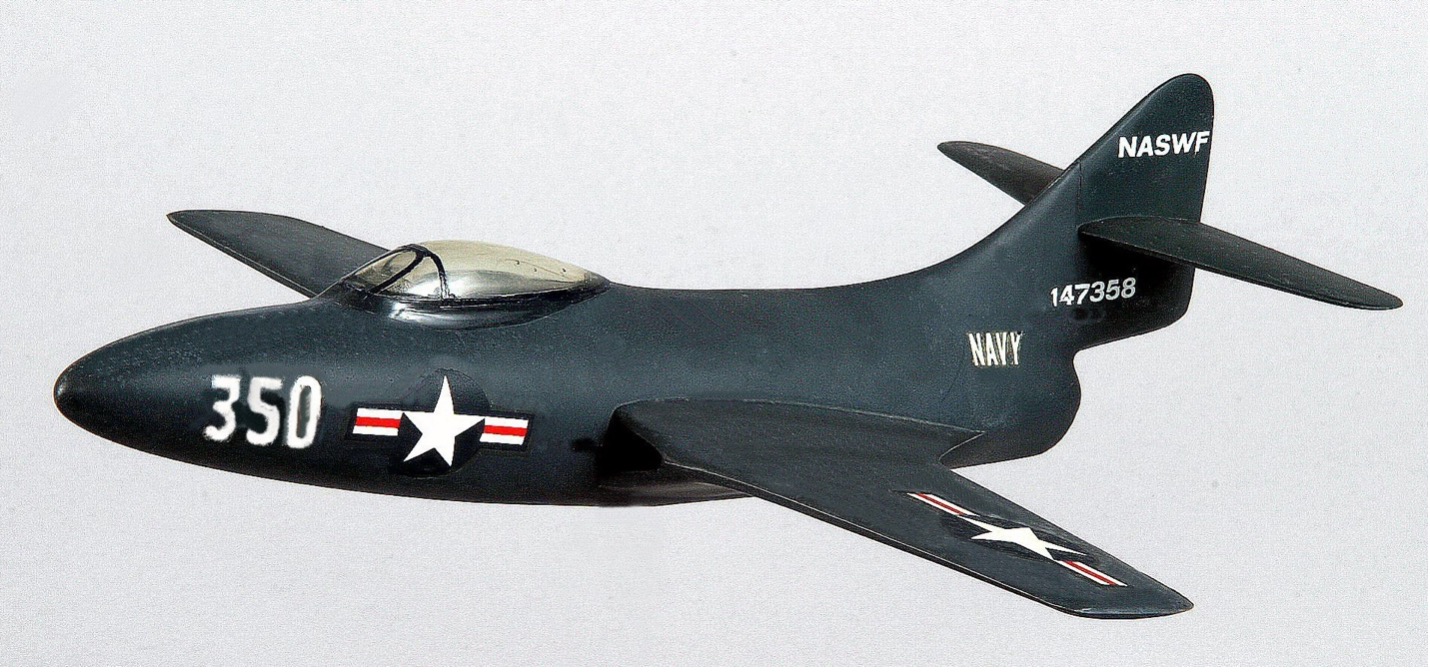USN NASWF Grumman F9F-1 Panther

MODEL BY:
Norm Roper
Model Scale:
1/48
MODEL ADDED:
10/30/1965
historical significance
First Albuquerque Visit: 1952
Additional Information:
The Grumman F9F Panther was an early US Navy carrier-based jet fighter. As the Navy’s second all jet carrier based fighter, the Panther was the last of the straight winged jets. The Panther replaced the F2H-1 Banshee and was eventually replaced by the swept wing F9F-8 Cougar.
Development of the Panther began in the final months of World War II to harness the recent innovation of the jet engine. Grumman designed a single-engine, straight-winged day fighter that was armed with four 20 mm cannons and could also carry a wide assortment of air-to-ground munitions. Production aircraft were usually powered by a single Allison J33 or Pratt & Whitney J48-P-2 turbojet engine. On 21 November 1947, the prototype performed its maiden flight, powered by an imported Rolls-Royce Nene engine. During September of 1949, the F9F was cleared for flight from aircraft carriers. The Panther was used extensively by the U.S. Navy and Marine Corps in the Korean War. The Panther was the first jet aircraft used by the Blue Angels from 1949 to 1954.
Albuquerque’s Kirtland Field was designated Kirtland Air Force Base in 1947, and the Armed Forces Special Weapons Project (AFSWP) operated on Sandia Base. When the United States Air Force established the Air Force Special Weapons Command at Kirtland Air Force Base in 1949, the United States Navy formed a detachment to investigate nuclear capabilities for naval aircraft and assist the AFSWP with naval equipment for demonstrations and training. The Naval Weapons Evaluation Facility (NWEF) operated through the Cold War investigating aircraft-weapon interfaces to provide United States Navy aircraft with nuclear weapons delivery capability.
In 1952 this detachment was designated the Naval Air Special Weapons Facility (NASWF) to conduct special weapons tests on the White Sands Missile Range and Tonopah Test Range in coordination with the United States Atomic Energy Commission. In March of 1961, the NASWF was re-designated the Naval Weapons Evaluation Facility (NWEF) and its mission was expanded to include safety studies on nuclear weapons. The aircraft used for NWEF testing were decorated with the NWEF thunderbird symbol and the NWEF detachment became known as the Rio Grande Navy by its sailors and civilians.
In 1992, with the consolidation of many naval activities and the drawdown of the U.S. defense budget, NWEF became part of the large, multisite Naval Air Warfare Center Weapons Division in China Lake. In 1993 the NWEF was decommissioned and became the first nuclear-weapons-related facility in the Free World to be shut down. As NWEF closed, it transferred some of its remaining people and functions to the China Lake site.
In 1952, a Grumman F9F Panther, Bu No. 147358, received weapons suitability testing at the Naval Air Special Weapons Facility (NASWF) at Kirtland Air Force Base in Albuquerque, New Mexico.
In the 1950’s a Panther jet crashed on Kirtland AFB. The Marine pilot amazedly, although being hurt, survived the crash. The newspaper photo below show all of what was left after the accident.
GALLERY:
SEARCH OUR DATABASE:
